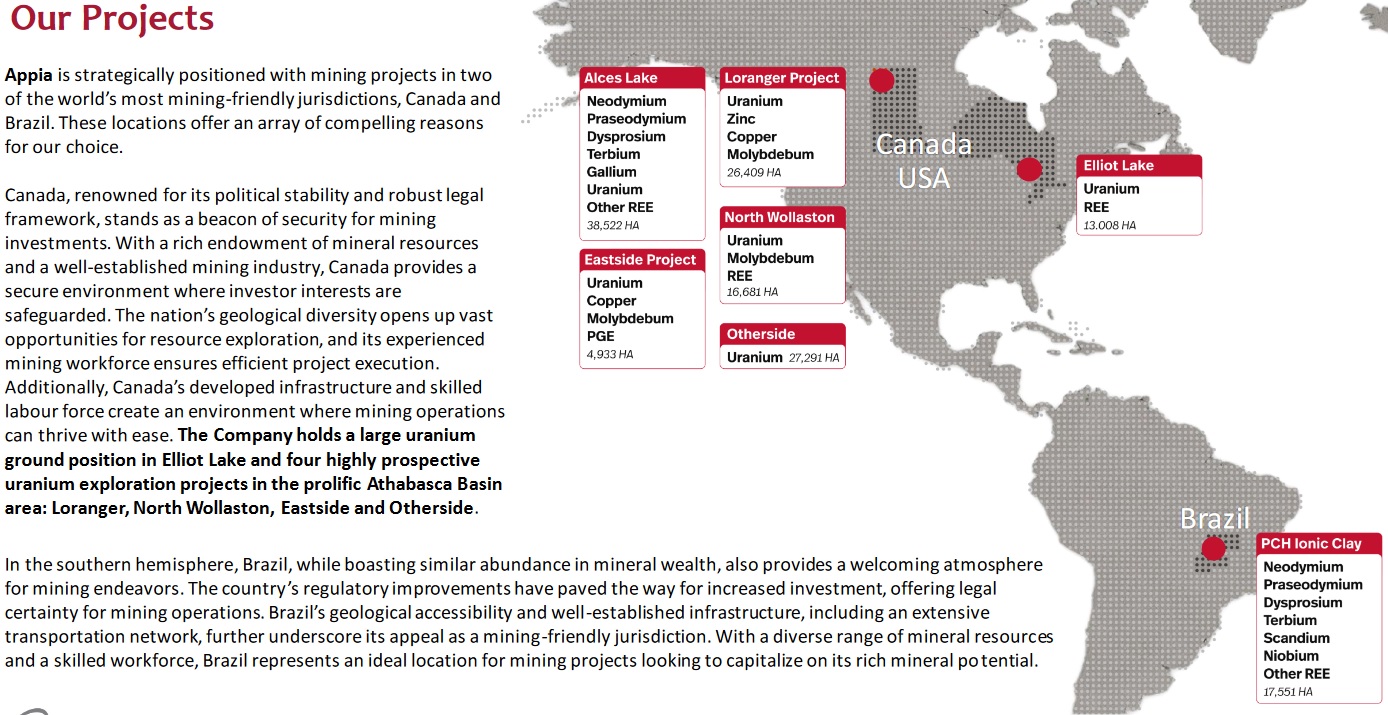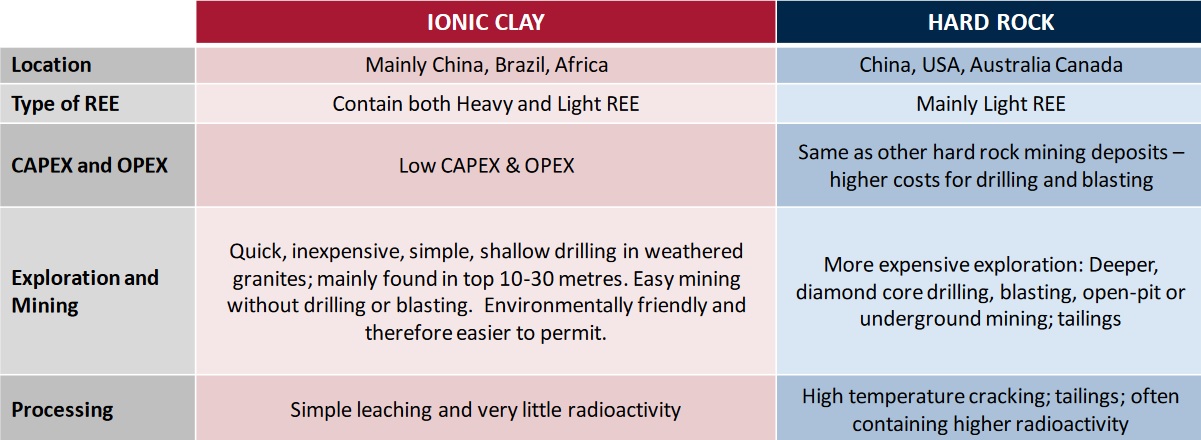“Amazing discovery… I keep making this point that there is a deficit of rare earths worldwide and Appia is the premier rare earths discovery in North America.” — Jack Lifton, Global Critical Materials Expert
A mineral discovery is the natural occurrence of a specific chemical compound or a mix of chemical compounds, which may be processed mechanically and chemically to isolate one or more forms of individual chemical elements, and then be purified and converted into useful forms for industrial use. If the discovery is extensive enough and the contained chemical compounds are of a sufficiently high enough grade for efficient and economical separation of them from each other and then can be further processed into forms that can be utilized industrially, then the large-scale production and concentration of the initial mineral concentrate is called mining.
How do you evaluate a rare earth discovery? The best way is to determine if it contains “valuable” rare earth elements, which can be economically and efficiently recovered in the jurisdiction in which it is located, in such quantities that the capital expended can be recovered at a profit.
The old-timers (aka, experienced exploration geologists and mining engineers) have just two simple metrics they use in first determining whether or not there is any point in answering this question: Grade and accessible tonnage.
Appia Rare Earths & Uranium Corp.‘s (CSE: API | OTCQB: APAAF) rare earth discovery at Alces Lake, Saskatchewan, meets the first of the above requirements, and the company is now in the process of a comprehensive drill program to determine if the second one is met as well.
The Appia discovery is of the mixed rare earth mineral, monazite, the most desirable rare earth bearing mineral on the planet. Monazite was the original rare earth mineral mined commercially in the late nineteenth century, not for rare earths, but for its contained thorium, which was heated, as an oxide in the form of a mixed ceramic mantle, with natural gas, to produce a brilliant white light for illuminating the stage in theatrical performances. Monazite fell out of favor as a mineral resource after World War II because of thorium’s natural radioactivity being highlighted as a danger in the early atomic age. Of course, electric lights, had by then long eclipsed the need for thorium.
In the 1950s though, thorium again became of interest when it was discovered that nuclear reactors for the commercial production of electricity could be fueled with thorium, which could not easily be used to make nuclear weapons. Anglo-American Mining in that period discovered the highest-grade thorium and rare earths deposit then known in the world in South Africa and began producing thorium for the UK’s civilian nuclear reactor program. Thorium reactors fell out of favor by the mid 1960s and thorium (monazite) mines were shut down, even though they were associated with high grade rare earths, because of the problems of disposing of the thorium and the then extremely expensive processes for separating the rare earths from each other, ion exchange, and fractional crystallization.
The discovery of a huge primary, accessible, mineable deposit of the rare earth mineral bastnaesite at Mountain Pass, California, in the late 1940s, and the development in the 1960s of the commercial application of solvent extraction to the separation of the rare earths, led to the eclipse of the use of high thorium monazites by bastnaesite as the primary mineral for rare earth mining.
The development of the rare earth permanent magnet in the late 1970s, at first using the rare earth element, samarium, and the rare earth elements neodymium and praseodymium, revived interest in monazite, because monazite contains 50% more, by weight, of neodymium and praseodymium, than bastnaesite.
However, the low thorium bastnaesite in California, because of its accessibility, became the world’s largest source of the magnetic rare earths, samarium , neodymium and praseodymium by the early 1980s. It was eclipsed by the bastnaesite recovered, more economically, as a byproduct of iron mining in China’s Inner Mongolia by the late 1980s. The Chinese iron deposits also contained some monazite, and this was processed there also to recover the rare earths. The thorium co-produced was stored, but its radioactivity ultimately led China to bring its control under the aegis of its China Nuclear Corporation (CNC), which stored it along with any other thorium produced as a byproduct of rare earths or its own uranium minerals processing.
Today, as Chinese bastnaesite grades seem to have declined from high grading and as pollution (environmental) consciousness has come of age in China, monazite, as a source of magnetic rare earths has revived dramatically in China. And China has become the world’s largest processor of monazite. Chinese mining and processing companies already import nearly 40% of their rare earth ore needs annually. They get bastnaesite from California and CNC is licensed to process up to 5o,ooo tons per year of monazites containing up to 30,000 tons of rare earths. All monazite imported into China must first go to CNC for thorium and uranium removal, before it goes to the Chinese purchaser, which will then recover the rare earths contained. China buys monazites as ore concentrates from the USA (until very recently), Brazil, Madagascar, Australia, and Myanmar, and Chinese companies are scouring the world seeking more.
The Chinese had the use of monazites as a source of magnetic rare earths to themselves until 2017, when Australia’s Lynas Rare Earths (ASX: LYC) went into commercial production and separation of the individual rare earths from its massive monazite mine at Mt. Weld, Australia. Then. in 2020, the only privately owned licensed uranium ore processor and thorium storage facility in the USA, Energy Fuels Inc. (NYSE American: UUUU | TSX: EFR), began a project to process monazite for its rare earths and to stockpile and sell the uranium recovered and store the thorium. Energy Fuels is and remains the sole such facility in the Americas. Its business plan is to become vertically integrated by building, on-site, a separation facility, and a rare earth metals and alloys operation also.
Energy Fuels has acquired domestically produced American monazite from the heavy mineral sands operations of The Chemours Company, and is actively seeking additional materials both domestically and internationally. Energy Fuels has already produced and sold commercial quantities of mixed rare earth carbonates cleaned of uranium and thorium.
Now, at last, we come to Appia and Canada’s entry into the rare earths’ mining and processing arena.
Australia’s Vital Metals Limited (ASX: VML | OTCQB: VTMXF) is now mining bastnaesite just outside of Yellowknife in Canada’s Northwest Territory from a high-grade deposit discovered by Avalon Advanced Materials Inc. (TSX: AVL | OTCQB: AVLNF) and licensed to Vital. The ore concentrate will be first sent to an operation being built by the Saskatchewan Resource Council (SRC), a Crown Corporation, where the uranium and thorium will be removed and a mixed rare earth carbonate produced for use in further downstream processing. The first such production has already been pre-sold to both American and European processing customers.
But the SRC has plans to construct not only a cracking, leaching, and radioactive recovery and storage system (Saskatchewan is Canada’s largest uranium mining and processing province, so the business there is well established and understood), but also a rare earths separation system in the form of a dedicated solvent extraction facility, the first of its kind in Canada.
Now we come to Appia Rare Earths & Uranium Corp., a Canadian company, originally exploring for uranium in Saskatchewan’s world-famous Athabasca Basin. About 5 years ago its then geologist discovered a dramatically high-grade sample of monazite on the company’s Alces Lake Property in Saskatchewan. He soon found that the sample had come from an outcrop showing extensive monazite veining. He continued to explore the area and predicted that the monazite field was extensive. Analysis of samples he took showed that it was also the highest grade neodymium rich monazite ever found in North America.
I was a speaker that year at a Metal Events’ Rare Earth Conference in Henderson, Nevada, and the Appia geologist, James Sykes, was an attendee. I had never met him, but we shared a cab to the airport, and he excitedly told me the Alces lake, monazite, story. I was intrigued, but I had reservations about the thorium and uranium that would be present in such a high-grade material. I thought of the highest grade rare earths deposit ever worked, Steencompskraal, in South Africa, which was actually worked as a thorium mine with no interest (in the 196os) in the rare earths contained. I didn’t then know of the monazite project in China or CNC’s role in it. I listened politely to Mr Sykes and wondered what anyone would do with this discovery if it were confirmed to be extensive enough to qualify as a NI 43-101 resource.
Did I mention that James Sykes also said that he believed the extended discovery to be near surface, so that a quarrying operation would obviate the need for underground operations?
It is now the Spring of 2022, and Appia has raised approximately $15.5 million in the last year. This funding is for a drilling program which is underway to prove a resource.
Energy Fuels is processing monazite, the Saskatchewan Resource Council has approved $31 million to acquire monazite, and other rare earth ore concentrates, and build a first of its kind in Canada cracking and leaching and separation facility dedicated to rare earths, and Canada’s Ucore Rare Metals Inc. (TSXV: UCU | OTCQX: UURAF) has begun construction of a Strategic Metals Center in Alaska for the central processing of critical metals, beginning with rare earth mixed carbonates from a variety of sources including Canadian and Australian monazites.
Appia’s drilling results so far are very encouraging, and have been extensively reported.
I think we may see the highest grade neodymium-rich monazite in the America’s flow from Alces lake before 2025. If so, It will certainly be in high demand.
Did I mention that the Appia monazite discovery contains 1% of xenotime, the hard rock mineral source of yttrium, dysprosium, and terbium? A one-stop-shop for magnet makers?
The stars and this planet are coming into alignment for this one. Monazite is back.
Disclosure: Jack Lifton is a member of Appia Rare Earths & Uranium Corp.’s Advisory Board and the Advisory Board for Energy Fuels Inc., and may hold securities or options in some of the companies mentioned in the above article.






